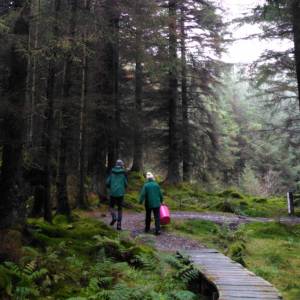Ant Aftermath
Continued from previous page:-
It's about three pm and we are turning left at Scotch Corner with two vans filled with Ants - to be specific, Hairy Wood Ants (Formica lugubris) Boxes containing tens of thousands of them fill the entire carrying space. They don't know it but they have been chosen as pioneers, to re-colonise a landscape that lost its Wood Ants many years ago. They are being moved, queens, workers, drones, babies, eggs in the pile of debris and earth they once called home and they need to be placed in their new site by nightfall.
We keep in touch by radio with the other van, and with the small group of staff and volunteers that are assembling to greet and help re-house the new arrivals.
Then comes some bad news. The big forwarder that we had hoped would carry the boxes up into the forest for us has broken down and what’s worse has done so before it has cleared the high forest road of fallen trees. That route to the second release site is now impassable.
Is there another way up? There is, but it consists of a steep winding footpath ascent from the valley floor to the top of the tree line and then a walk of about 2km along forest road. With the best will in the world this is too far to carry the heavy boxes by hand.
Quickly, our Re-wilding officer makes a decision. She puts out a call to one of the foresters to collect all the wheel barrows he can find, load them onto the truck and bring them over to the meeting point. We will use them, one box and two people per barrow and move the load that way.
The sun is already slanting through the trees when eventually we reach the first release site. This is the easy one with road access within 20 yards. The volunteers are ready and waiting to unload the boxes with the first two nests and take them to the shallow pits they dug previously. It’s the work of moments then to tear off the cotton covers and gently tip out the contents of the boxes, one on top of the other in the right order- re-assembling the nest and its frantic inhabitants. Between the layers we lay small branches to give them some air and structure. It’s good to see that the workers immediately start to bury eggs and pull at the roofing materials. From a jam jar the winged queens are released onto the top of the mound. A delicious mix of mushed banana, apple, honey and mealworms is dolloped at intervals nearby as high protein/calorie supplement. We all have smiles on our faces and fingers crossed that they’ll be happy and thrive.
But now comes the challenge of reaching the second site, with ants intact before nightfall. Further along the valley track the truck is waiting with 8 barrows but the forester who has brought them is not well. He thinks he has food poisoning and certainly looks rough, so he elects to look after everyone’s packs. This is devotion beyond the call of duty as later, after he gets home, he is rushed into hospital with appendicitis.
Meanwhile the rest of us wrestle the barrows over the first stile and load them with boxes. And then unload them to get over the parched stream bed. And then load them again following what seems like a near vertical rabbit track up the open fellside Thank goodness the ground is dry and the bracken low. But we are all struggling by the first 30 yards. After the morning’s digging, I find I can barely push the weight of the barrow and so I elect to carry the lightest box up by hand. I count the steps, 20 paces with it held on the left, 20 on the right and a rest until recovery. By the time I get to the top stile the other barrows have been lifted over and have disappeared with their boxes on the 2km push over unmetalled track.
I wait for the last two foresters who are carrying the last two boxes up between them but decide to leave mine on the roadside until a barrow comes back. One does come at last pushed by a very weary volunteer and I can load my box and start the long trek. I am very happy when another, fitter looking volunteer arrives and says he will take it the last stretch.
It’s been a hard slog for translocators and translocated alike but at the end of the day there is the view of a beautiful and beloved valley which now hopefully has one of its many lost species restored to it.
- 1
- 0

Comments
Sign in or get an account to comment.


